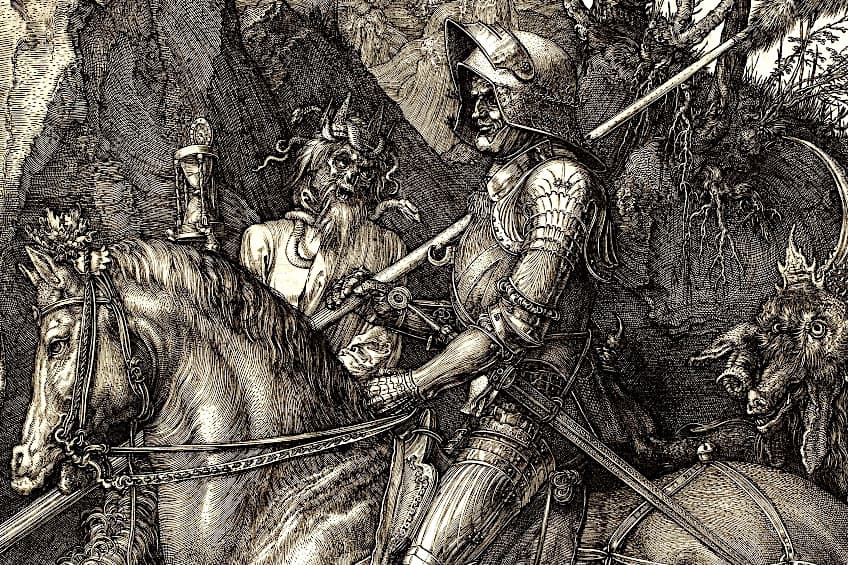Albrecht Dürer – Master of the German Renaissance
Who was Albrecht Dürer? A pioneer of the German Renaissance, Albrecht Dürer was one of the most famous German artists and printmakers who were recognized for his contribution to woodcut printing, engravings, etching, and painting. In this article, we will dive into the life and artistic career of the influential Albrecht Dürer, including his extensive body of work, which is celebrated for its integration of proportion, mathematics, and classical motifs from the Northern Renaissance. We will also help answer questions such as “What is Albrecht Dürer known for?” and provide you with some top-rated book recommendations for a complete Albrecht Dürer biography.
Contents
An Albrecht Dürer Biography
Who was Albrecht Dürer? Where was Albrecht Dürer born? And what is Albrecht Dürer best known for? Albrecht Dürer, artist and master etcher, was one of the greatest German Renaissance artists of all time. Below, we will unpack a complete Albrecht Dürer biography according to the German artist’s major accomplishments, artworks, and contributions to the Northern Renaissance that will have you in awe of this spectacular master engraver!
| Artist Name | Albrecht Dürer (the Younger) |
| Date of Birth | 21 May 1471 |
| Date of Birth | 6 April 1528 |
| Nationality | German |
| Movement(s) | Northern Renaissance, German Renaissance, and Gothic art |
| Medium(s) | Oil painting, watercolor, etching, woodcut printing, engraving, writing |
| Most Famous Artwork |
|
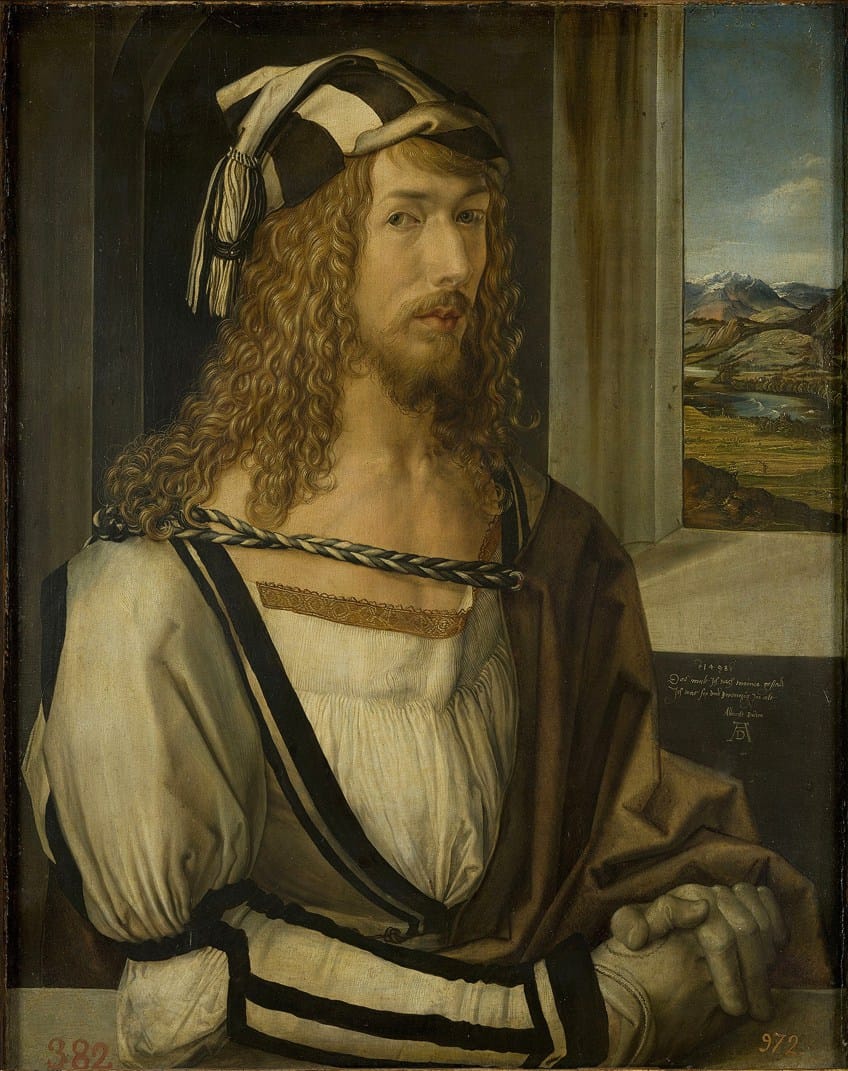
The Early Life of Albrecht Dürer the Artist
Born in 1471 in Nuremberg under the Holy Roman Empire of Germany, Albrecht Dürer (1471-1528) was the son of German artist Albrecht Dürer the Elder (1427-1502), also known as Albrecht Ajtósi who was a well-known goldsmith during the 15th century. The Dürer family was large with Albrecht Dürer being one of 17 children. Dürer the Elder married Holper once he received his qualification as a master and then settled in Nuremberg. One of Albrecht Dürer the Younger’s brothers, Hans Dürer, was also an artist who trained under their father.
Dürer’s godfather, Anton Koberger, also established himself as one of the most accomplished publishers and printers in Germany, owning approximately 24 printing presses and numerous offices both locally and throughout Europe.
There is no doubt that the Dürer family was successful across painting, publishing, and printing, and thus Albrecht Dürer can be thought of as the Dürer who combined this valuable pool of knowledge to create some of the most iconic etchings and paintings of the Northern Renaissance. Koberger was the main publisher behind the famous 1493 publication, the Nuremberg Chronicle, which consisted of more than 1,809 woodcut images executed by the Wolgemut workshop.
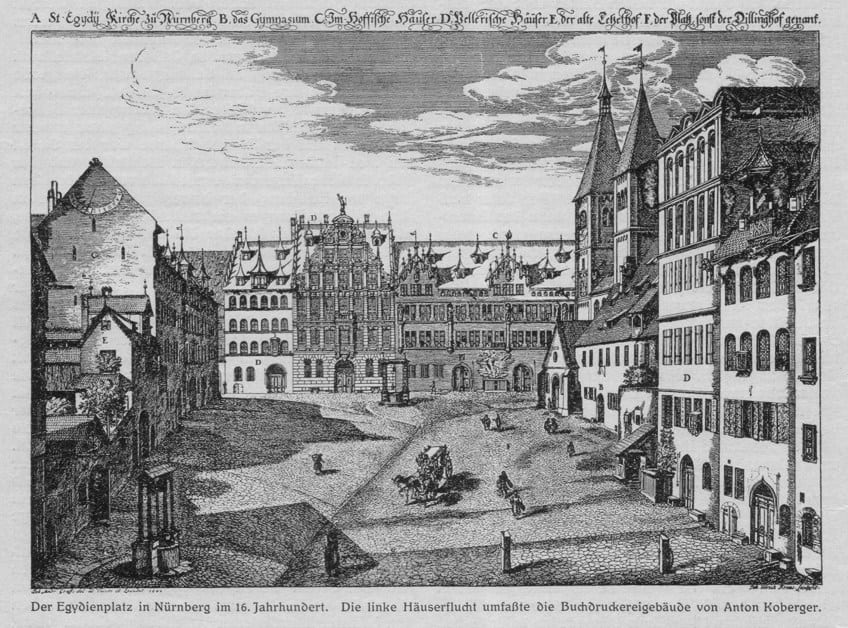
From an early age, Dürer showed promise in both goldsmithing and drawing, but later went on to pursue drawing over a career as a goldsmith and began his training under the guidance of Wolgemut by age 15. The Wolgemut workshop was one of the best woodcut workshops in Nuremberg, run by Michael Wolgemut who was also a prolific painter and printmaker who helped Dürer achieve immense recognition. Dürer was cited in at least several sources by his twenties. Talk about not missing the mark!
Albrecht Dürer’s first self-portrait was created when he was only 13 years of age using a drawing technique passed down to him from his father. His self-portrait is also the earliest surviving drawing titled When I was a Child and is dated 1484.
The drawing is considered to be Dürer’s opus one, with the artist himself remarking that its creation contributed to the development of his oeuvre. When I was a Child is a silverpoint drawing that is executed by dragging a silver wire or rod across a prepared surface, usually coated in primer or gesso. This drawing technique is an ancient practice that was used primarily by craftsmen, scribes, and artists and is defined as a type of metal-point.
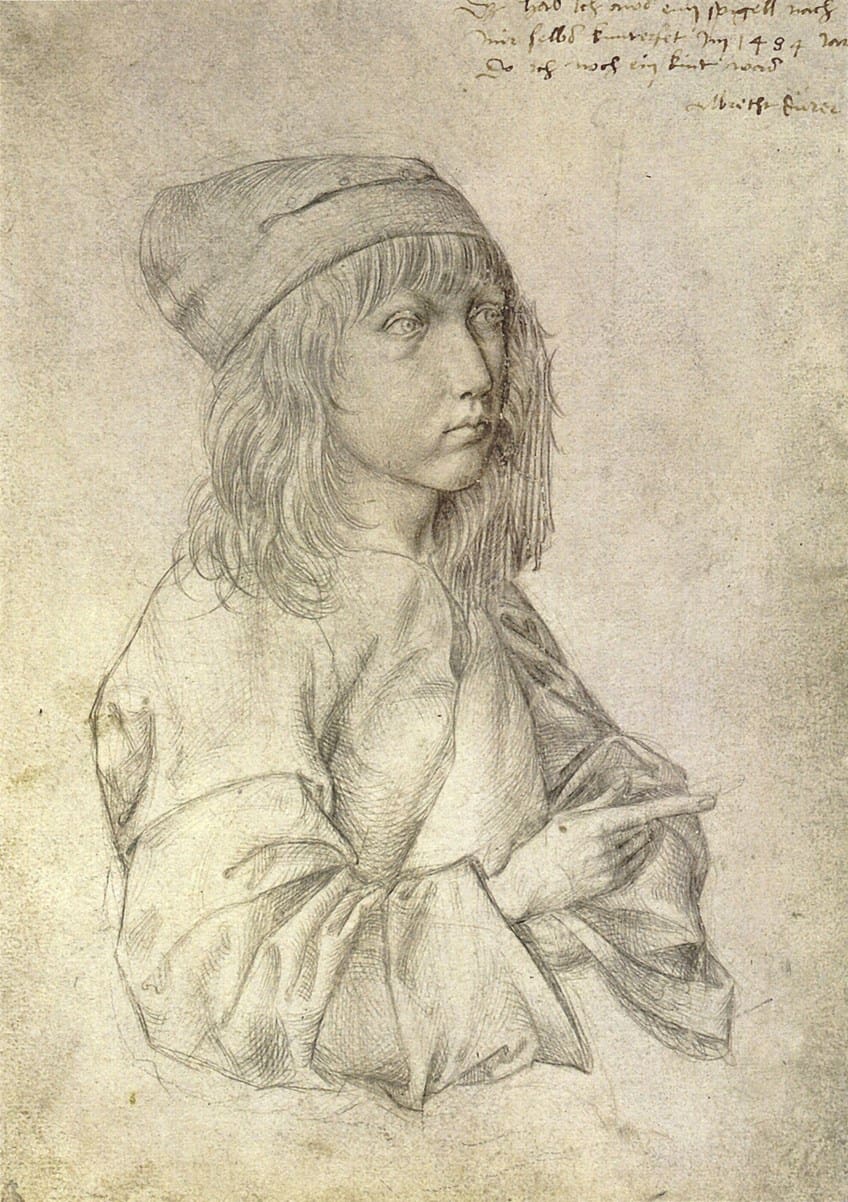
The Apprentice Becomes the Master: Life After Wolgemut
Upon completion of his training, Dürer took a few gap years, referred to in German as wanderjahre, and is defined as the period during which an apprentice would gather skills learned from other artists of the trade.
Dürer’s wanderjahre lasted four years and moved on to practice art under the direction of Martin Schongauer, who was Northern Europe’s most famous engraver who unfortunately passed away before Dürer could even arrive at Colmar.
When he did arrive in Colmar, he was greeted by Schongauer’s brothers, Caspar, Paul, and Ludwig with the latter brother being a painter. By 1493, Dürer traveled to Strasbourg where he discovered the sculptural talents of Nikolaus Gerhaert and it was during this time that he created his first self-portrait, which is currently housed at the Louvre Museum. Dürer then made his way to Basel where he took up residence with another brother of Schongauer, Georg, and by 1494, he returned to Nuremberg. By this year, Dürer was already 23 years old.

Not long after his return to his hometown, Dürer was married via arranged marriage to Agnes Frey, whom he experienced a turbulent marriage with, with remarks by Dürer describing his own wife as being an “old crow” and a “shrew”.
According to a theorist, Dürer was rumored to be either bisexual or homosexual, with themes of same-sex sexuality seen in some of his works and tones of desire expressed in correspondence with his close male companions.
In light of his unhappy marriage, Dürer left for Italy within three months on a solo trip after the plague outbreak in Nuremberg. This trip was evidence enough of his disdain for his relationship with Frey, who was also accused by Dürer’s friend Willibald Pirckheimer of being responsible for Dürer’s early death.
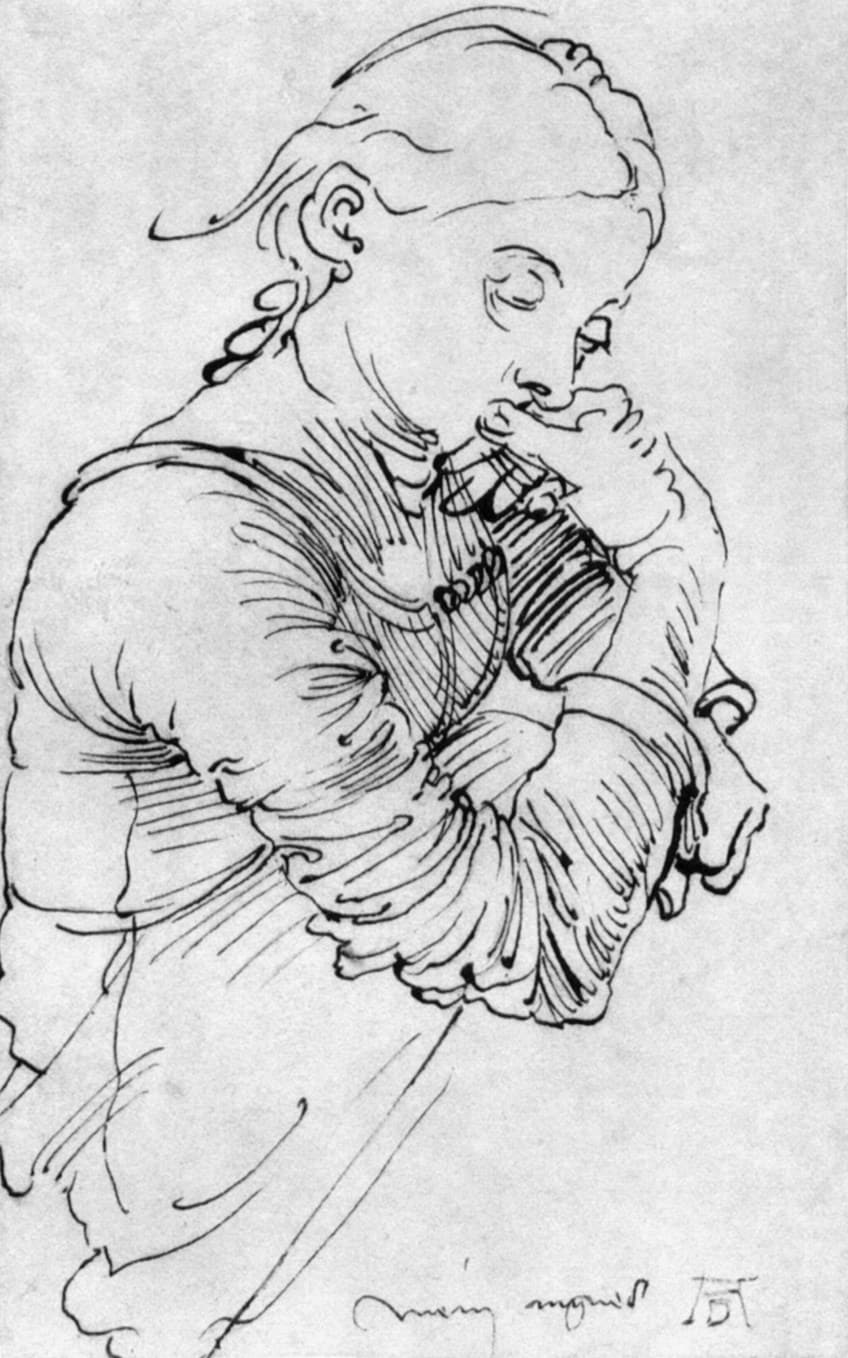
The Relentless Pursuit of Happiness: Italy
After his turbulent and almost cold-hearted departure from his wife in Nuremberg, Dürer made his way to the Alps where he dove into an exploration of watercolor. One of his surviving works from this period is Nemesis (1502-1502), which is on the list of Dürer’s most famous engravings.

The wanderlust-filled artist then made his way to Venice where he commenced his study and immersion into the broader art landscape of Italy and experimentation with techniques such as drypoint etching. The trip to Italy proved to be the most influential artistic endeavor that Dürer encountered. It was during this trip that he discovered the work of Giovanni Bellini, who at the time was one of Venice’s leading artists and revolutionary leader in Venetian painting.
Other key figures who influenced Dürer include artists such as Antonio del Pollaiuolo, Lorenzo di Credi, and Andrea Mantegna.
In 1505, Dürer made his second trip to Italy where he reignited his love for painting and created a special series of paintings made with tempera on linen cloth. The series included both altarpieces and portraits with the most recognized works identified as Adoration of the Magi (1471-1528) and the Paumgartner altarpiece, which was commissioned in the early 16th century.
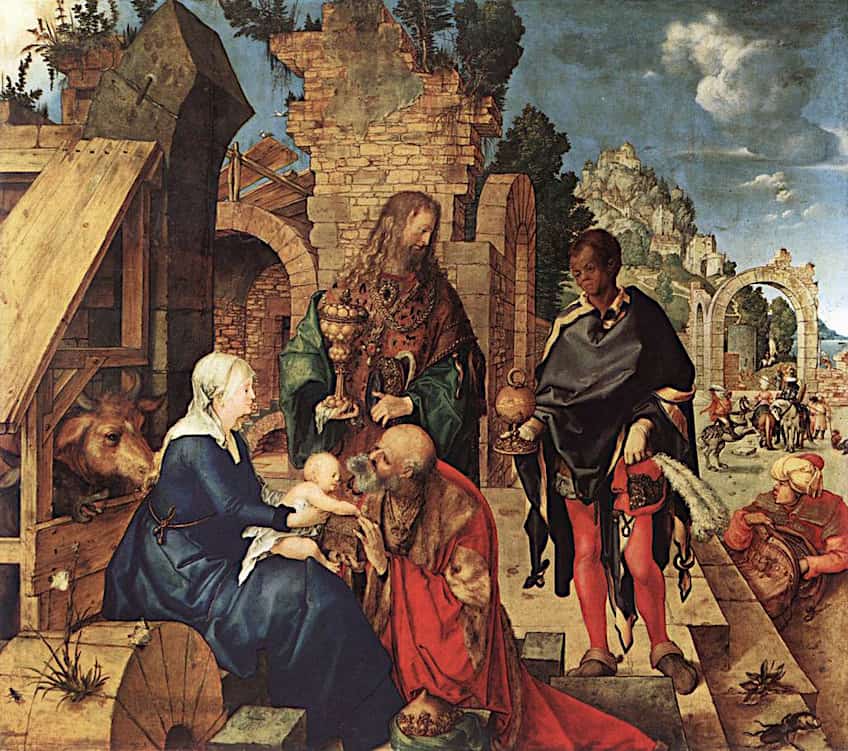
During his second visit to Italy, Dürer had already gained a mass following and was incredibly famous for his engravings. He was also granted a career-defining commission by the church of San Bartolomeo for the creation of Feast of Rose Garlands, also known as Adoration of the Virgin (1506).
The painting featured portraits of various members of the German community in Venice complemented by the influence of Italian art. Adoration of the Virgin (1506) was then moved to Prague after its acquisition by the Holy Roman Emperor, Rudolf II.

The Nuremberg Years
Before the artist’s second trip to Italy and elevated status, his time in Nuremberg proved to be a period of development regarding the artist’s career in woodblock design and printing. In 1495, Dürer set up his workshop, which was a strange requirement at the time for married individuals.
Dürer’s first trip to Italy was so inspirational that the following five years were led by his newfound Italian enlightenment and adaptation of woodcut printing styles from Northern art influences.
Many of Dürer’s woodcut prints produced during the late 15th century portrayed religious subjects and secular scenes as seen in the 1496 woodcut print The Men’s Bath House. Dürer’s talent for composition and balance was mastered during this period and is evident in the arrangement of figures and use of perspective in his prints to create a complex scene.
The production of the woodblocks for the printing process was believed to have been left to specialists and other trained professionals, as opposed to Dürer, an established printer, reverting to the “menial” tasks.
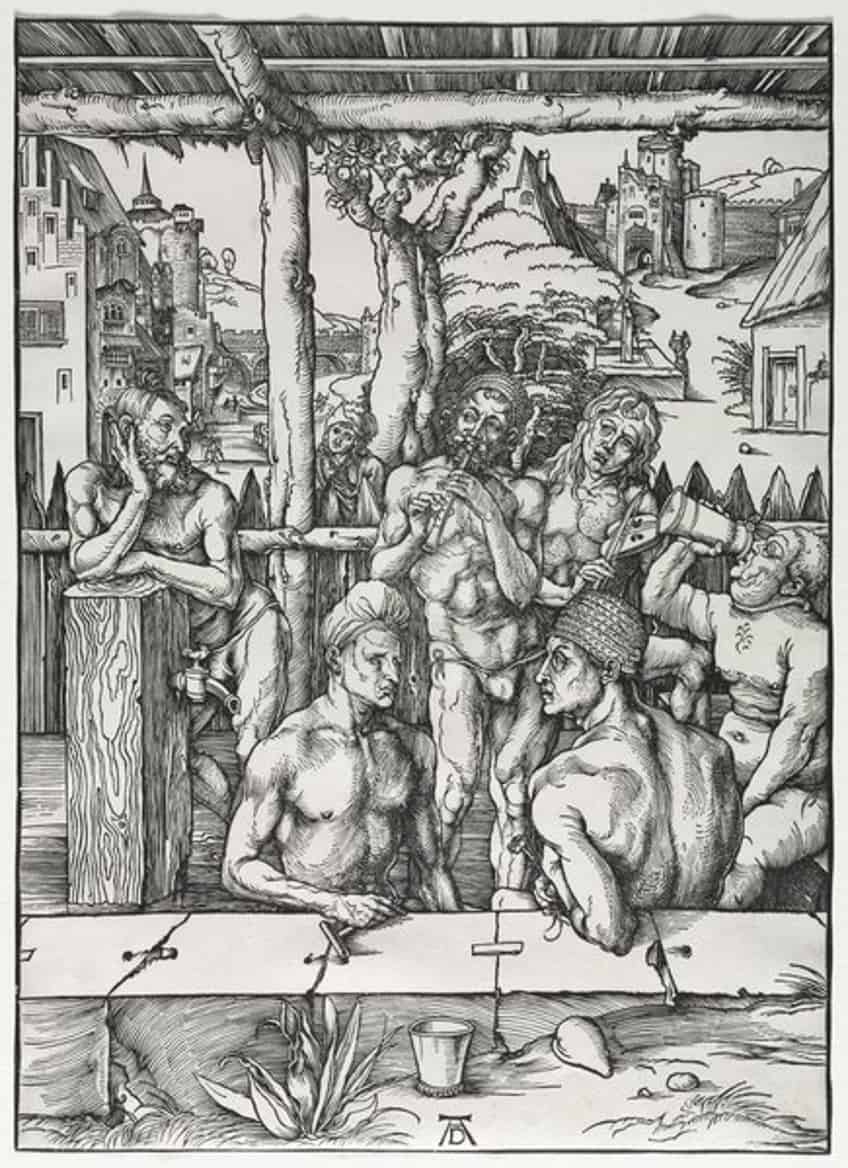
It was not that he was above reverting to time-consuming processes, rather, Dürer had already amassed a deep understanding of the craft since his tutelage at the Wolgemut workshop. Dürer designed his own woodblocks by either directly carving onto the wood panels or attaching a piece of paper with a design on the block for carving.
During Dürer’s stay in Nuremberg, he also taught himself how to incorporate the use of burin to produce his engravings. Burin refers to a steel-cutting tool, also identified as a graver or chisel used specifically for engraving in intaglio, woodcut, and relief printmaking. It is believed that Dürer was exposed to this device through his father who would have utilized a burin for his job as a goldsmith.
The Patron: Maximilian I
By 1512, the Holy Roman Emperor Maximilian I became a patron to Dürer and commissioned Triumphal Arch, which is a large woodcut print created from 192 different woodcut blocks and inspired by Horapollo’s treatise, Hieroglyphica (5th century). Other contributors to this major commission included Johannes Stabius who took control of the design program, Jörg Kölderer, a court painter and expert builder who took control over the architectural design, and Hieronymous Andreae who oversaw the woodcutting process. Triumphal Procession (c. 1515-1517) was also one of the most famous Albrecht Dürer woodcuts, commissioned by Maximilian and printed using more than 130 woodcut blocks created by several artists.
Dürer had also created many portraits for Maximilian up until his death in 1519. Despite being loaded with wealth, Maximilian was also known to be shoddy with paying his artists but considered Dürer to be one of his best artists.
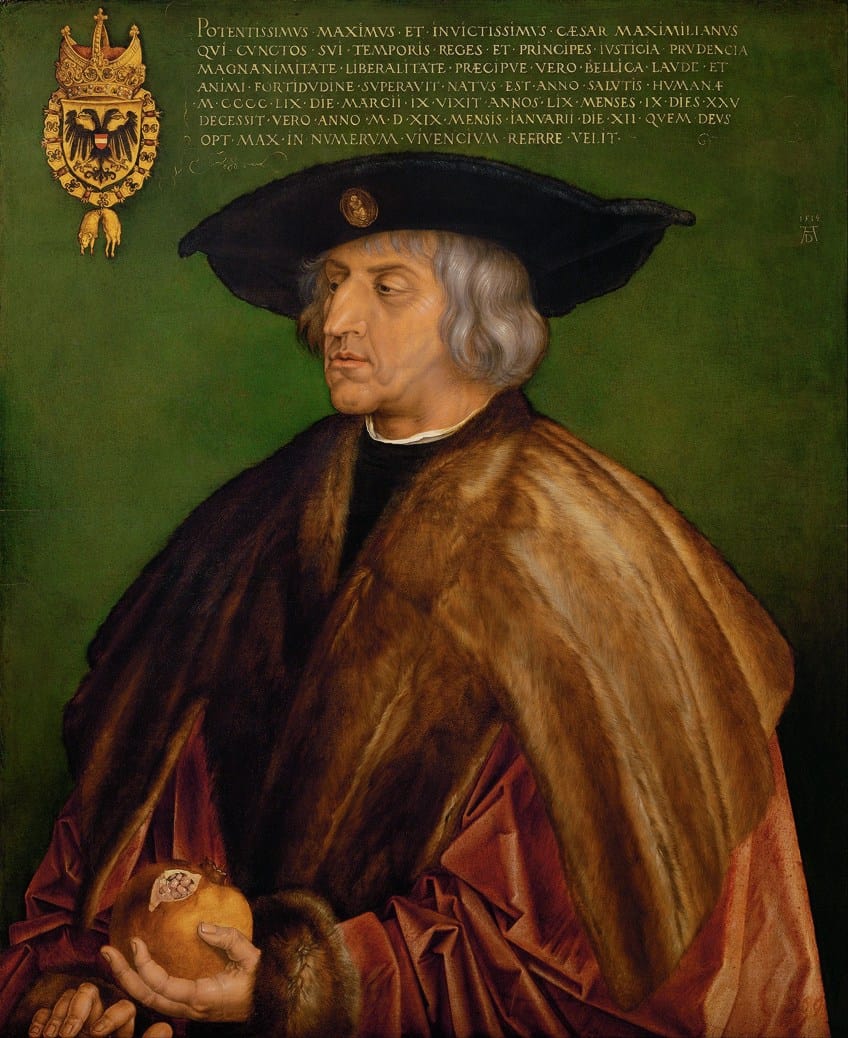
In addition to participating in multiple commissions and significant projects, Albrecht Dürer also created one of the first books published in lithography, which was a prayer book printed for the Emperor and published around 1808. However, Dürer’s progress in contributing to the final published version was halted for unknown reasons and resumed by other artists such as Hans Baldung and Lucas Cranach the Elder.
During this time, artists and educated men such as Dürer were not often respected in noble environments and Dürer himself recognized this treatment and stated that he was treated like a parasite.
Maximilian also defended Dürer in his own court on one occasion where he took note of Dürer’s ladder being too short and somewhat unstable. Maximilian commanded that one of his noblemen support the ladder for Dürer, but the nobleman refused out of discrimination towards the artist for not being noble. Maximilian himself stepped up to the task and wielded the power of his authority by stating that he could make any peasant into a nobleman but he could not turn a nobleman into an artist like Dürer.
This bold display of loyalty toward Dürer showed just how much he was respected by the king and demonstrates the level of influence he had on such powerful figures.
Challenges and Death
Toward the end of Dürer’s life, around 1519, he faced a decline in health as well as poor eyesight and arthritis in his hands, which slightly impaired his abilities yet he continued to travel with his restless spirit. During this period, Dürer traveled to both the Netherlands and Brussels for a year and then settled back in Nuremberg by 1521.
It is believed that he contracted malaria from the trip, which caused his health to slowly degrade and he experienced a period of frequent fevers, during which his art production declined. It was also around this time that he left many of his paintings incomplete but continued to paint smaller works.
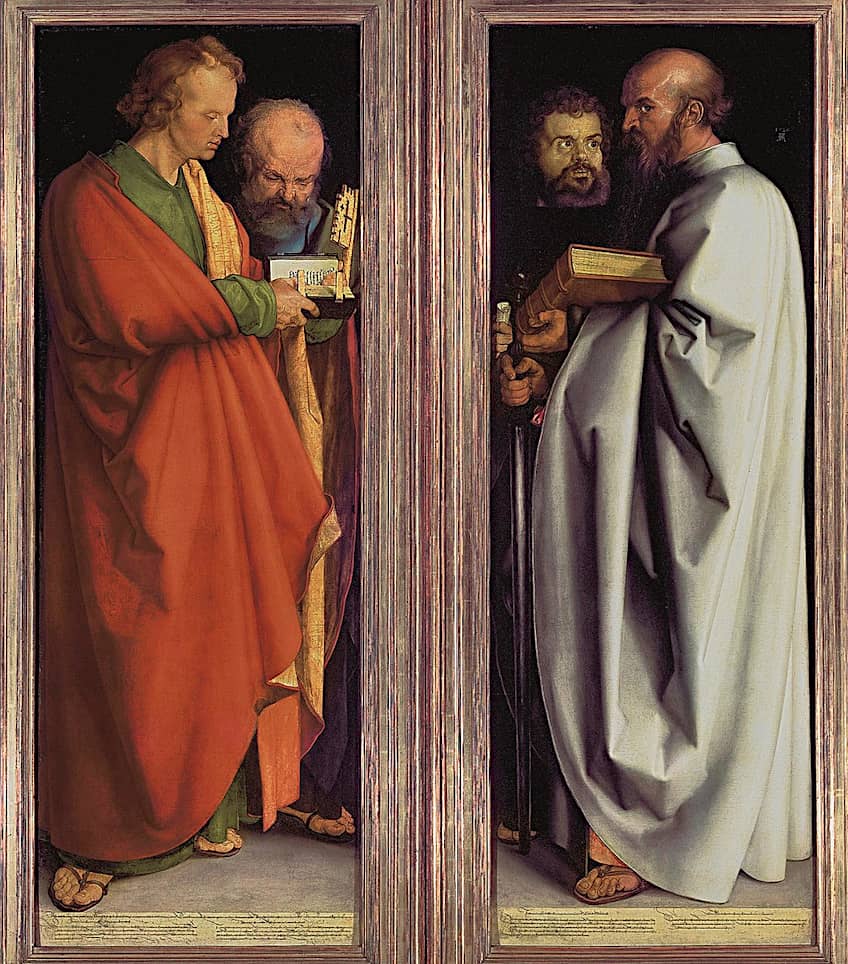
Toward the end of his life, Dürer’s fascination for the sciences was more prevalent and his last significant artwork was in 1526, with the creation of The Four Apostles. Dürer persevered despite his declining health and went on to publish treatises featuring his own engravings and illustrations. He eventually passed away in his hometown in 1528 at the age of 56 and his estate was transferred to his widow.
Dürer’s close associate, Pirckheimer, had a statement inscribed on Dürer’s tombstone stating, “What was mortal of Albrecht Dürer lies beneath this mound”.
Dürer was laid to rest in Johannisfriedhof cemetery in Nuremberg, Germany. The Vienna Academy of Arts also holds a lock of Dürer’s hair, which was originally a gift sent to one of his students, Hans Baldung. Nevertheless, Dürer’s legacy will forever echo across art history for his contribution to printmaking, etching, woodcut, and painting.
Important Projects by Albrecht Dürer
Throughout his lifetime, Albrecht Dürer made a significant impact on the printmaking scene of the Northern Renaissance, but he also expanded his talents in other disciplines and projects that helped bolster his career, reputation, and legacy. Below are some of Albrecht Dürer’s most notable projects.
Treatises: Measurement, Fortification, and Human Proportion
In the first quarter of the 16th century, Dürer began publishing a series of treatises that explored the topics of measurement, divine proportion, and mathematical subjects that he felt were essential to the development of all artists.
Dürer, as with many great artists of the Renaissance, believed that geometry was the key to creating harmonious works and thus he privileged the marriage of art, science, and mathematics as the key to success.
His published works include Four Books on Measurement (1525), Treatise on Fortification (1527), and Four Books on Human Proportion (1528). Humanism was also a major contributing factor to the interests of Renaissance artists and invited the exploration of the natural world, including animals, plants, the latest discoveries, and domestic creatures.

Cartography and Astronomy
Dürer was not limited to just printmaking and painting, but he was also a collaborative artist who was not afraid of branching out into other domains. One might recognize the importance of space in art with its ties to pictorial illusionism and an overall understanding of the world around oneself.
Dürer was no stranger to the fields of astronomy and cartography as seen in his engagement with Johannes Stabius, a court astronomer of Vienna and Austrian cartographer who also supported Dürer through the financial crisis.
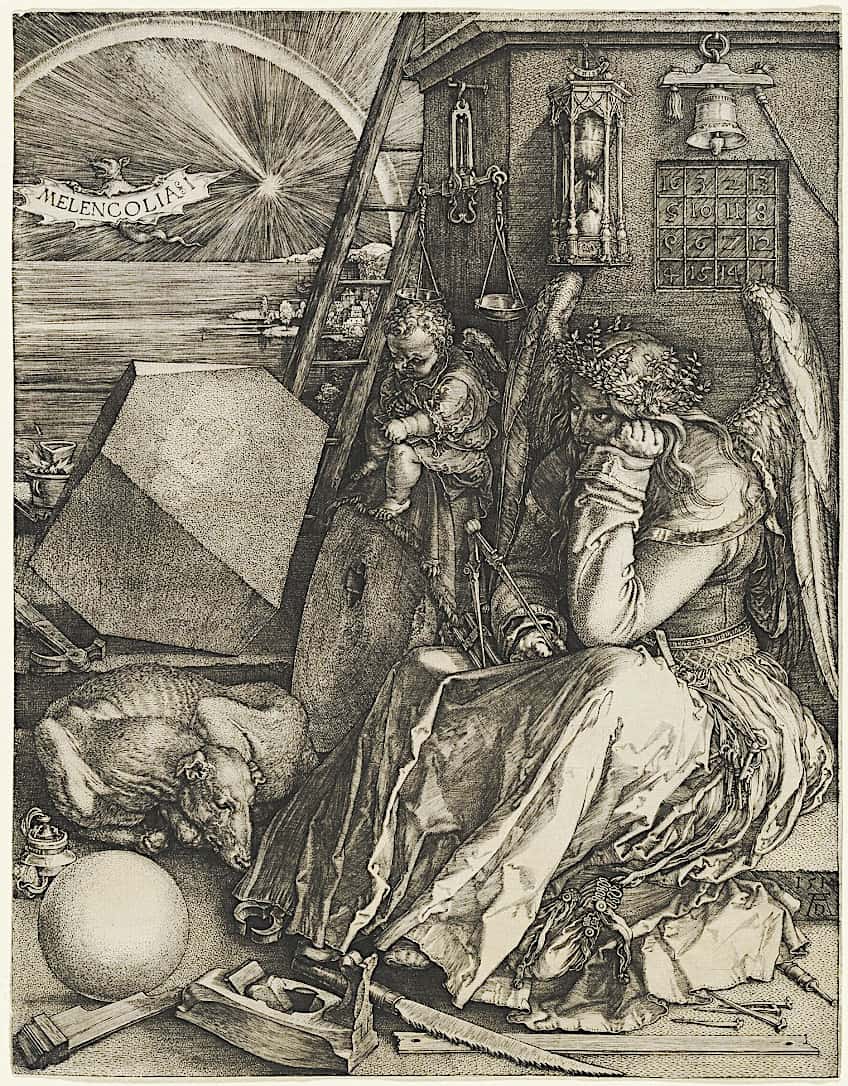
Albrecht Dürer is not only celebrated as an influential German artist but he is also credited with being the co-creator of the first world map, created in 1515 in partnership with Stabius.
This world map was projected onto a geometric sphere and in the same year, the duo received another collaborator, Konrad Heinfogel, who helped Dürer and Stabius to create the first print of a celestial map of the Northern and Southern hemispheres. This was a major development in history that revived the field of uranometry in Europe.
Notable Artworks
The art of Albrecht Dürer spans a variety of mediums, including painting, printmaking, and writing. His different experiences in Europe throughout the 16th century, as well as contemporaries such as Leonardo da Vinci and Raphael, had a significant impact on his relentless pursuit of expanding his use of mediums such as etching and woodcut printing.

Some of the most famous Albrecht Dürer woodcuts include works like Saint Jerome (1492), Christ Bearing the Cross (1494), The Men’s Bath (c. 1496-1497), The Four Horsemen of the Apocalypse (1496-1498), and The Fall of Man (1509-1510).
Dürer’s talent in portraying human emotion, contrast, perspective, and light was combined with his imaginative vision of many popular religious themes as seen in famous Albrecht Dürer etchings and engravings.
Below, we will analyze and discuss some famous Albrecht Dürer engravings and paintings that showcase the skill and influence that the German artist possessed.
Albrecht Dürer Paintings
Early on in his career, Albrecht Dürer displayed an interest in drawing and even likened charcoal to a scepter and was thus his power. Art was power to the German artist and he demonstrated this in many of his early works. Among his early works are his watercolor and oil paintings, which we will delve into below.
The Large Piece of Turf (1503)
| Date | 1503 |
| Medium | Watercolor, pen, and ink |
| Dimensions (cm) | 40.3 x 31.1 |
| Where It Is Housed | Albertina, Vienna, Austria |
The Large Piece of Turf is a watercolor painting created by Albrecht Dürer in his Nuremberg workshop. The painting contains a quaint group of wild plants such as dandelion, germander speedwell, daisies, smooth meadow grass, hound’s tongue, greater plantain, and yarrow, all of which form part of Dürer’s exploration of Realism in nature.
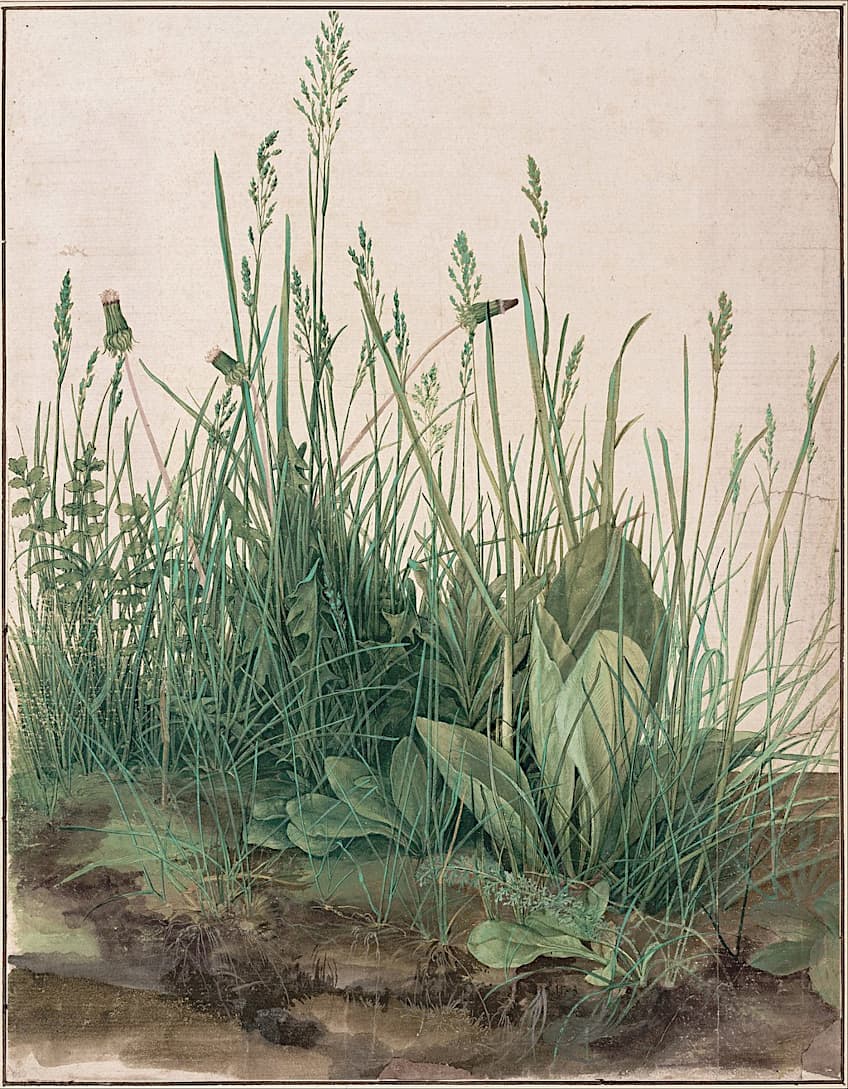
Dürer’s hand at portraying realistic natural elements was masterful as seen in the small portion of visible earth and the plant roots, which indicate Dürer’s awareness of the natural environment and his meticulous attention to detail.
Although simple, the watercolor painting shows off Dürer’s years of practice in the medium and his appreciation of the natural environment.
Salvator Mundi (c. 1505)
| Date | 1505 |
| Medium | Oil on linen |
| Dimensions (cm) | 58.1 x 47 |
| Where It Is Housed | Metropolitan Museum of Art, New York, USA |
This unfinished linen painting by Albrecht Dürer is one of his most famous paintings, currently housed at the New York Metropolitan Museum of Art. This classical image of Jesus Christ holding a crystal orb while raising his right hand for the blessing is an iconic religious image that was also previously created by Leonardo da Vinci around 1490.
The painting was created around 1505 and was recorded in the collection of Willibald Imhoff as “der Salvator”, a painting that was “not quite finished by Albrecht Dürer”. The element that stands out the most is the unfinished face of Christ against the green background. After the painting’s restoration in 1861, it was observed that only the background, drapery, and Christ’s hair were finished while the crystal globe was somewhat abandoned halfway. After this, the painting’s owner attempted to finish the painting and employed a restorer known as Anton Deschler to finish the job.

Salvator Mundi was finally cleaned and restored to its original state by 1940, which exposed other unfinished areas. There was also no question as to the authenticity of the work belonging to Albrecht Dürer since the underdrawing of Christ and other areas of the painting matched the skills of the German artist. It is believed that in the early stages of drawing, Dürer also paid close attention to the modeling of the orb concerning the lighting and shading. He also offset the contours of the drapery to illustrate the refraction of the light and its effect on the drapery.
What makes this painting special is that it is one of few paintings that contain careful design choices such as the refraction of light that could only be found in a limited number of artworks by Dürer.
One of the primary theories around why Dürer would abandon this work includes the fact that he probably fled Nuremberg after the onset of the plague, however, you may be further intrigued to know that oddly enough, this was the only painting that he abandoned at the time. Could this have something to do with his unhappy relations in Nuremberg?
Virgin and Child with Saint Anne (1519)
| Date | 1519 |
| Medium | Oil on linen |
| Dimensions (cm) | 60 x 49.8 |
| Where It Is Housed | Metropolitan Museum of Art, New York, USA |
Virgin and Child with Saint Anne is one of the most famous Albrecht Dürer paintings of the 16th century that shows his preferred subject for the medium of painting, religion. The painting portrays the iconic image of the Virgin Mary (Madonna) with Jesus Christ (the child) as an infant and Saint Anne seated higher up in the plane than in traditional paintings of Saint Anne, which show her supporting Christ while seated or standing with Jesus in her hands.
Virgin and Child with Saint Anne were commissioned by Leonhard Tucher based in Nuremberg and the painting remained with his family up until 1628. By 1630, king Maxmilian purchased the painting during one of his acquisition sprees, acquiring many works by Dürer for storage in Munich.
Prior to this, Maximilian refused to believe that the painting was an original work by Dürer and rejected the work. The work had then been subject to controversy not long after its purchase by Maximilian and was deemed a copy.
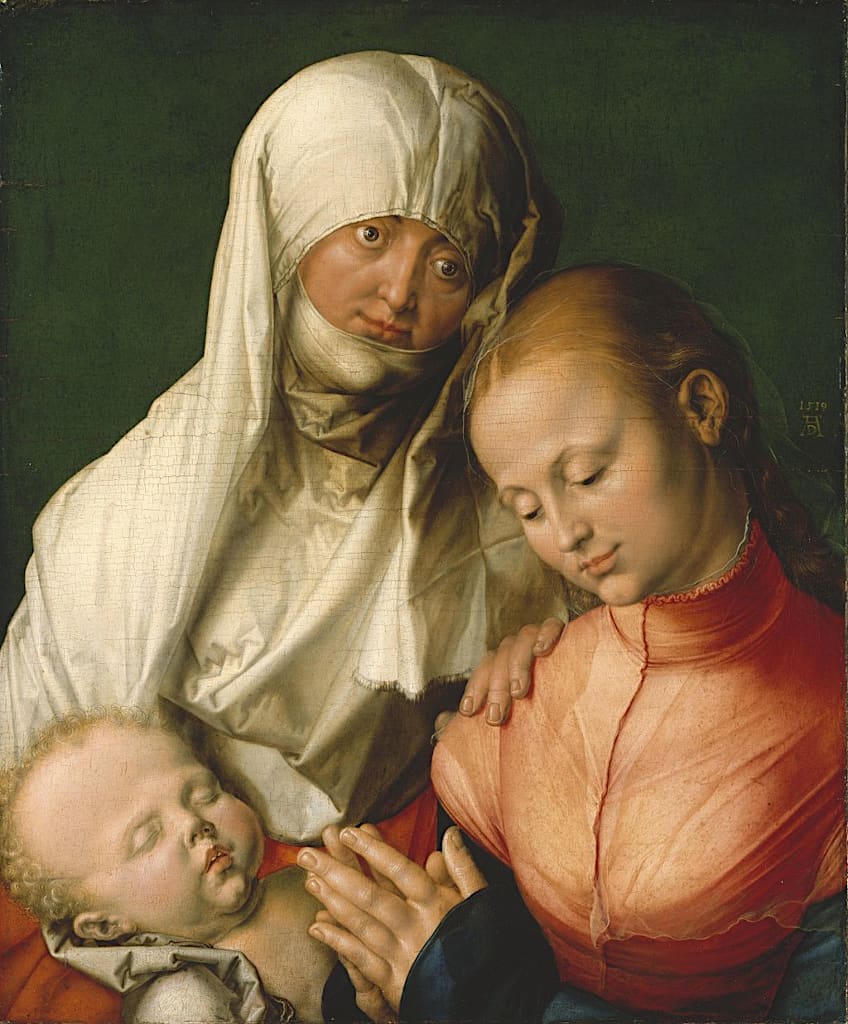
The painting is also referred to as Anna selbdritt, which translates directly to “Anne in a group of three” and was an incredibly popular work at the time due to the emergence of the cult of Saint Anne, also understood as the mother of the Virgin. The sleeping baby Jesus serves as a motif for his later death and was most likely inspired by Giovanni Bellini. The relation to Jesus’ later death is also highlighted in Dürer’s use of blue on the infant’s face, which alludes to death.
Saint Anne is depicted with a distant gaze that reflects a foreshadowing of Christ’s passion with her hand on Mary’s shoulder acting as a gesture of consolation rather than a congratulation. Through these careful decisions on the expressions and gestures of the figures, Dürer aptly conveys a birds-eye meditation on the arrival of Christ and summarizes the narrative in this cropped scene.
Albrecht Dürer Engravings
Now that we have examined a few Albrecht Dürer paintings, we can now explore some famous Albrecht Dürer engravings that show Dürer’s transition and dedication to engraving. Below, you will find some of his most famous engravings from the 16th century that will have you struck with admiration at the artist’s technical skill.
Die Vier Hexen (1497)
| Date | 1497 |
| Medium | Engraving |
| Dimensions (cm) | 19 x 12.7 |
| Where It Is Housed | Metropolitan Museum of Art, New York, USA |
Die Vier Hexen translated in English refers to the engraving by Albrecht Dürer called the Four Naked Women and is a reference to erotic temptation, witchcraft, ad classical mythology. The print was created at a period during which the illustration of nudes in engraving and drawing was restricted so this work was a bold move on Dürer’s part.
The print contains four naked women, each with different hairstyles standing in an interior space. A small devil appears on the left and is meant to symbolize evil and is seen holding an object crafted from string and sticks. The object is presumably a device used for hunting fowl or birds.

The use of different hairstyles on the women indicates that they are from different social backgrounds since headdresses were a signifier of social status during medieval and early Renaissance times. At the time, Nuremberg was also a place where women had to follow the social order, which was governed by the Nuremberg council. The figure on the left is seen wearing a bonnet called a haube, which signals that she is a married woman while the woman on the far right is adorned with a lengthy folded veil called a schleier, which signifies that she is a middle-class citizen.
There is more to this engraving than simply the depiction of four naked women. Despite scholars not fully knowing Dürer’s true intentions behind his engravings, it has been theorized that the subject’s interpretation can range based on how one views it. Some theories behind the four women include the representation of the four seasons, references to Aphrodite or Venus, prostitution, the three fates, the graces, or simply four “witches”.
Given Dürer’s exploration of engraving, he may have selected this composition as an interesting way to explore the female nude through different social classes during a time when nudity was somewhat censored.
The Sea Monster (1498)
| Date | 1498 |
| Medium | Engraving on Japon paper |
| Dimensions (cm) | 24.8 x 18.7 |
| Where It Is Housed | Private collection |
This antiquarian-style Albrecht Dürer engraving is one of the German artist’s early prints that illustrates the mythical sea creature. The unique subject of the engraving is what distinguished this engraving from the rest and is crammed with movement, action, and narrative.
The Sea Monster refers to a merman who is seen on the far right of the print holding a tortoiseshell shield as he captures the woman next to him.
The merman appears to have abducted the woman from her lover, who is seen upset by the incident, standing on the shore in the distant background. The background also contains a countryside or village scene that enhances the entire scene and adds a fairytale-like quality to the scene.
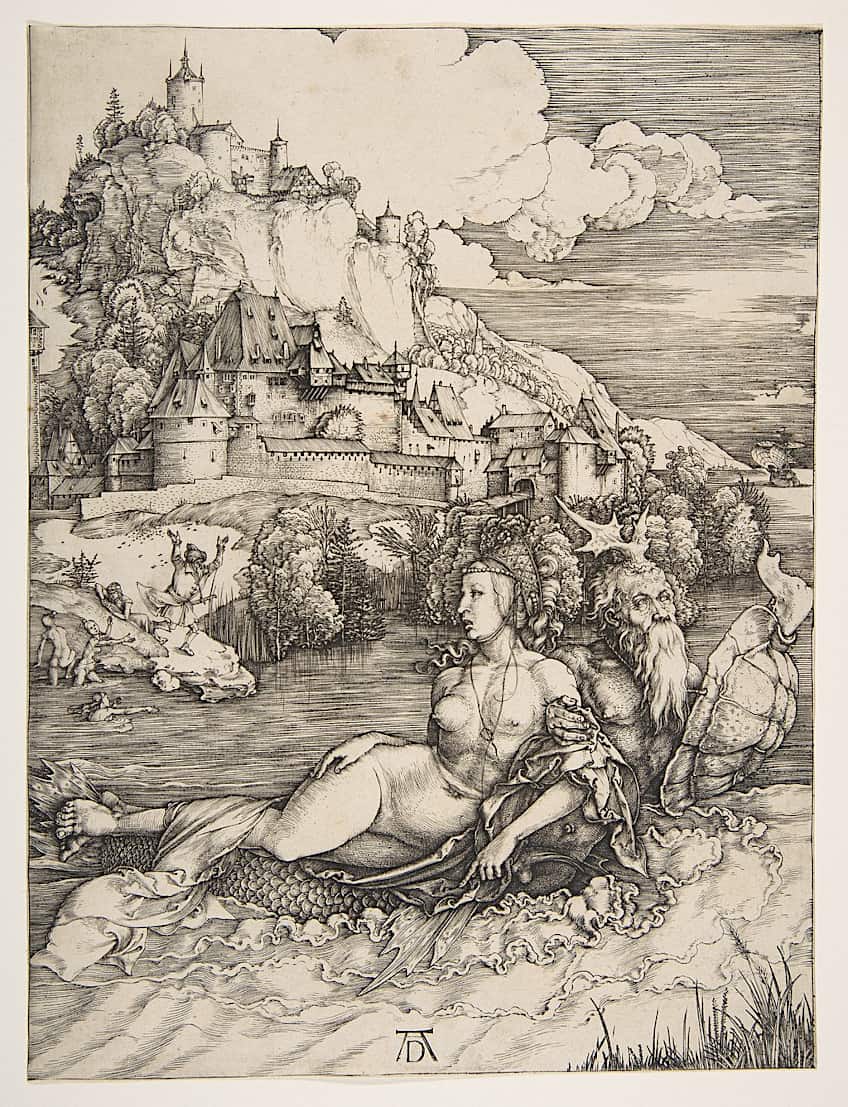
Another admirable quality of the engraving is Dürer’s depiction of the waves in the foreground that point to the fact that the scene is occurring in the present, as though we have just witnessed the abduction of the woman and the escape of the merman at play.
Dürer’s excellent use of shading techniques in engraving through a combination of darker and lighter lines as well as negative and positive space makes this engraving remarkable, to say the least. The imaginative quality of this work truly makes this one of the best Albrecht Dürer engravings.
Knight, Death, and the Devil (1513)
| Date | 1513 |
| Medium | Engraving |
| Dimensions (cm) | Sheet: 25 x 19.6; Plate: 24.3 x 18.8 |
| Where It Is Housed | Metropolitan Museum of Art, New York, USA |
Housed at the New York Metropolitan Museum of Art, Knight, Death, and the Devil (1513) was created during a period when Dürer chose to focus solely on engraving. Known as the master of engraving itself, Dürer referred to this print as the “rider” and based the print on the image of a Christian soldier from Erasmus’ Instructions for the Christian Soldier (1504).
An extract from Instructions for the Christian Soldier reads: “In order that you may not be deterred from the path of virtue because it seems rough and dreary…and because you must constantly fight three unfair enemies…the flesh, the devil, and the world…this third rule shall be proposed: all spooks and phantoms which come upon you as if you were in the very gorges of Hades must be deemed for naught after the example of Virgil’s Aeneas…Look not behind thee”.
Knight, Death, and the Devil shows Dürer’s rendition of a knight galloping past Death on his pale horse.

The knight serves as the physical embodiment of moral virtue founded on the Italian tradition of heroic equestrian portraits, which inspired Dürer’s choice of subject and gives one an indication of the artist’s thought pattern. Death is portrayed with an hourglass in his hand symbolizing the brevity of life. On the far right are a devil with a pig’s head and a hilly terrain in the background. The image is grim and Dürer’s expert engraving technique amplifies the atmosphere of the scene.
Other famous Albrecht Dürer etchings and engravings include works such as Adam and Eve (1504), The Agony in the Garden (1515), and The Engraved Passion series (1507-1513).
Book Recommendations About Albrecht Dürer
These paintings and engraving illustrations are only a few of the famous Northern Renaissance artist’s works that hold strong connections to crucial developments in his career. Below, you will find a list of top-rated book recommendations that will provide you with a full Albrecht Dürer biography as well as insight into his engravings, paintings, and life projects.
The Complete Engravings, Etchings and Drypoints of Albrecht Dürer (1972) by Albrecht Dürer and Walter L. Strauss
This highly-rated book contains the full series of etchings, drypoints, and engravings by Albrecht Dürer, edited by Walter L. Strauss. The book features 96 engravings and around 105 works in total that provide you with a clear visual of the fine workmanship of the master engraver. Dürer’s subjects include religious themes from the New Testament, peasant personalities, and depictions of the life of Saints. The engraving illustrations were reprinted for this edition such that you can marvel at the fine details of Dürer’s line work. This book is a necessary addition to the shelf of any Albrecht Dürer fan and is great for browsing some of the artist’s best print works.
- Affordable and detailed collection of Dürer's prints
- Top quality high-resolution images show every mark and line
- Each print is accompanied by rigorous commentary
Albrecht Dürer (2017) by Norbert Wolf
This superb find by Norbert Wolf is a perfect book for any collector of pioneering German artists. The book features a comprehensive set of illustrations by the Northern Renaissance artist and master engraver, Albrecht Dürer, including in-depth research on the artist and his career that resolve common arguments, misconceptions, and questions about Dürer’s life and career. This book presents Albrecht Dürer as both a man and an artist and provides a fresh perspective that will reinvigorate your view of the artist.
- Explores Dürer's interests and innovations beyond his art
- Well written and illustrated biography with a full catalog raisonne
- Contextualizes Dürer's work and his influence on subsequent artists
Durer’s Journeys: Travels of a Renaissance Artist (2021) by Susan Foister and Peter van den Brink
Available in hardcover, this five-star rated book on Albrecht Dürer is one of the best-selling publications written by Susan Foister and Peter van den Brink, detailing the international travels of the German artist, his career, and his legacy. This book is perfect for those searching for a full-coverage narrative of the master printmaker’s career and relations with artists from Italy.
- Rare compilation of artworks and documents detailing his travels
- Explores Dürer's interactions with Northern and Southern artists and patrons
- Examines Dürer's scientific and theoretical pursuits in the context of travel

From co-creator of the first map to his meticulous appreciation for historical subjects, Albrecht Dürer is a legendary figure. The work of Albrecht Dürer speaks volumes when it comes to visually expressing the personal interests and technical prowess of one of the greatest engravers in art history. Dürer’s diverse range in subject matter and interdisciplinary approach to envisioning the important aspects of Northern Renaissance culture in Europe is one that not only captures the essence of the time but also demonstrates a grasp of time and space itself.
Take a look at our Albrecht Dürer paintings webstory here!
Frequently Asked Questions
How Many Woodcuts Did Albrecht Dürer Create?
Albrecht Dürer created more than 300 woodcuts in his career. His work is still highly admired, making Dürer one of the best printmakers of his time.
What Is Albrecht Dürer Known For?
Albrecht Dürer was known for his mastery in printmaking, particularly woodcuts, engraving, and etching. He was also a master draftsman, painter, and author of various treatises on human proportion and mathematically-informed subjects, which propelled his artistic development. He is famous for contributing to the field of printmaking and for his artwork subject matter involving religious themes, history, and imaginative landscapes.
Where Was Albrecht Dürer Born?
Albrecht Dürer was born in Nuremberg Germany, on 21 May 1471 and was a prolific painter, engraver, and printmaker during the German Renaissance. He frequently returned to his hometown after traveling abroad to other parts of Europe, including Italy and Munich.
Jordan Anthony is a Cape Town-based film photographer, curator, and arts writer. She holds a Bachelor of Art in Fine Arts from the University of the Witwatersrand, Johannesburg, where she explored themes like healing, identity, dreams, and intuitive creation in her Contemporary art practice. Jordan has collaborated with various local art institutions, including the KZNSA Gallery in Durban, the Turbine Art Fair, and the Wits Art Museum. Her photography focuses on abstract color manipulations, portraiture, candid shots, and urban landscapes. She’s intrigued by philosophy, memory, and esotericism, drawing inspiration from Surrealism, Fluxus, and ancient civilizations, as well as childhood influences and found objects. Jordan is working for artfilemagazine since 2022 and writes blog posts about art history and photography.
Learn more about Jordan Anthony and about us.
Cite this Article
Jordan, Anthony, “Albrecht Dürer – Master of the German Renaissance.” artfilemagazine – Your Online Art Source. January 28, 2023. URL: https://artfilemagazine.com/albrecht-durer/
Anthony, J. (2023, 28 January). Albrecht Dürer – Master of the German Renaissance. artfilemagazine – Your Online Art Source. https://artfilemagazine.com/albrecht-durer/
Anthony, Jordan. “Albrecht Dürer – Master of the German Renaissance.” artfilemagazine – Your Online Art Source, January 28, 2023. https://artfilemagazine.com/albrecht-durer/.


